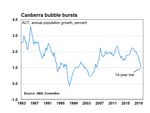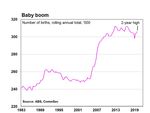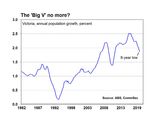Population growth hits 13 -year low; Baby boom Regional Aussie tourism hotspots - CommSec
←
→
Page content transcription
If your browser does not render page correctly, please read the page content below
Economics | June 18, 2020
Population growth hits 13½-year low; Baby boom
Regional Aussie tourism hotspots
Population; Tourism
Population: Australia’s population increased by 349,833 people over the year to December 2019 to
25,522,169 people. Overall, Australia’s annual population growth rate eased from 1.43 to 1.39 per cent –
the slowest pace in 13½ years.
Baby boom: There were 305,800 Aussie babies born in the year to December - a 2-year high.
Annual population growth by state and territory: Victoria (1.87 per cent annual growth rate – slowest in 8
years), followed by Queensland (1.57 per cent – slowest pace in 3 years), Western Australia (1.28 per cent
– fastest rate in 5½ years), NSW (1.13 per cent – slowest pace in 7½ years), the ACT (0.99 per cent –
slowest pace in 14 years), Tasmania (0.97 per cent), South Australia (0.90 per cent) and the Northern
Territory (-0.38 per cent).
Domestic tourism hotspots: Outside of the major capital cities, the NSW North Coast, Gold Coast,
Sunshine Coast, Tropical North Queensland, NSW South Coast, Hunter Valley and Australia’s South West
regions were amongst the biggest recipients of interstate and intrastate tourism spending in 2018/19.
The demographic data on jobs provides insights on the job market, wages and prices, and ultimately on interest rates. Tourism data is
important for airlines, hotels, shops and transport operators. The Chinese data is important for exporters, especially rural producers,
consumer goods, mining and energy companies.
What does it all mean?
Aussie population growth was easing even before the COVID-19 outbreak reached our shores and international
and state borders were shut. Annual population growth hit a 13½-year low of 1.39 per cent in December 2019.
Population growth rates eased across most states and territories in 2019, led lower by major cities on Australia’s
East Coast. Canberra’s population growth rate at 0.99 per cent was the weakest annual pace in 14 years. And
annual growth rates have fallen to near 8-year lows in Victoria and NSW. Queensland’s annual population growth
rate of 1.57 per cent was the slowest in 3 years.
That said, the resurgence in iron ore mining activity is luring more Aussies and overseas migrants to Western
Australia - posting the strongest annual population growth rate in 5½ years.
Ryan Felsman, Senior Economist
Twitter: @CommSec
IMPORTANT INFORMATION AND DISCLAIMER FOR RETAIL CLIENTS
The Economic Insights Series provides general market-related commentary on Australian macroeconomic themes that have been selected for coverage by the
Commonwealth Securities Limited (CommSec) Chief Economist. Economic Insights are not intended to be investment research reports.
This report has been prepared without taking into account your objectives, financial situation or needs. It is not to be construed as a solicitation or an offer to buy or sell any securities or financial instruments, or as a recommendation and/or
investment advice. Before acting on the information in this report, you should consider the appropriateness and suitability of the information, having regard to your own objectives, financial situation and needs and, if necessary, seek
appropriate professional of financial advice.
CommSec believes that the information in this report is correct and any opinions, conclusions or recommendations are reasonably held or made based on information available at the time of its compilation, but no representation or warranty is
made as to the accuracy, reliability or completeness of any statements made in this report. Any opinions, conclusions or recommendations set forth in this report are subject to change without notice and may differ or be contrary to the
opinions, conclusions or recommendations expressed by any other member of the Commonwealth Bank of Australia group of companies.
CommSec is under no obligation to, and does not, update or keep current the information contained in this report. Neither Commonwealth Bank of Australia nor any of its affiliates or subsidiaries accepts liability for loss or damage arising out
of the use of all or any part of this report. All material presented in this report, unless specifically indicated otherwise, is under copyright of CommSec.
This report is approved and distributed in Australia by Commonwealth Securities Limited ABN 60 067 254 399, a wholly owned but not guaranteed subsidiary of Commonwealth Bank of Australia ABN 48 123 123 124. This report is not
directed to, nor intended for distribution to or use by, any person or entity who is a citizen or resident of, or located in, any locality, state, country or other jurisdiction where such distribution, publication, availability or use would be contrary to
law or regulation or that would subject any entity within the Commonwealth Bank group of companies to any registration or licensing requirement within such jurisdiction.Economic Insights. Population growth hits 13½-year low; Baby boom
Perhaps the economic lockdown in the March quarter,
2020 may see a continuation of the mini baby boom?
There were already 305,800 babies born in the year
to December - a 2-year high!
With the Federal Government yesterday confirming
that Australia’s international borders will likely remain
shut until at least 2021 due to virus restrictions,
Aussies holidaying at home could provide a vital
lifeline for Aussie tourism businesses.
In fact, a record 11.3 million overseas trips were taken
by Aussie residents in 2019, up by 247,500 from
2018, according to the ABS, Austrade and Tourism
Research Australia (TRA) data. So which states had
the most outbound tourists? Unsurprisingly, NSW (34
per cent), Victoria (28 per cent) and Queensland (18
per cent) dominated the proportion of short-term
residents returning from overseas journeys in 2019.
And when holidaying, visiting friends and family, or travelling overseas for business, Aussies spent a gargantuan
$66.6 billion in other countries. So could this potentially offset the $45.4 billion in lost annual international tourism
income? Well, yes. Prior to the COVID-19 outbreak, Aussies undertook 117.4 million overnight trips, spending
$80.7 billion (interstate $45 billion/intrastate $35.7 billion) last year. And while some interstate borders remain
closed, it’s worth noting that intrastate travel (trips within a
traveller’s state of residence) accounted for around two
thirds of all trips in 2019, according to TRA data.
Australia’s state tourism satellite accounts were released
by Austrade a couple of weeks ago. The accounts
revealed that in financial year 2018/19, growth in Gross
Value Added terms (GVA – excludes taxes paid and takes
into account subsidies) was highest for Western Australia
(up 13.6 per cent), followed by Tasmania (up 11.1 per
cent), Victoria (up 10.8 per cent), Northern Territory (up 9.5
per cent), South Australia (up 8.3 per cent), Queensland
(up 3.3 per cent) and NSW (up 2.3 per cent). But GVA fell
in the ACT by 6.7 per cent. Across all states and territories,
domestic overnight visitors account for 57 per cent of total
GVA, followed by day trip visitors (13 per cent) and
international visitors (30 per cent).
So which Aussie regions could benefit from a lift in
interstate or intrastate visitors? Outside of the major capital
cities, the NSW North Coast, Gold Coast, Sunshine Coast,
Tropical North Queensland, NSW South Coast, Hunter
Valley and Australia’s South West regions were amongst
the biggest recipients of interstate and intrastate tourism
expenditure in 2018/19.
What do the figures show?
Population Statistics – December quarter
Australia’s population increased by 349,833 people
over the year to December 2019 to 25,522,169 people.
Overall, Australia’s annual population growth rate eased
from 1.43 to 1.39 per cent – the slowest pace in 13½
years. Natural increase contributed 39.8 per cent to the
annual lift in population with 60.2 per cent from migration.
Over the year to December, population growth was
strongest in Victoria (1.87 per cent), followed by
Queensland (1.57 per cent), Western Australia (1.28 per
cent), NSW (1.13 per cent), the ACT (0.99 per cent),
Tasmania (0.97 per cent), South Australia (0.90 per cent)
and the Northern Territory (-0.38 per cent).
June 18, 2020 2Economic Insights. Population growth hits 13½-year low; Baby boom
By state and territory, the ACT population growth rate at 0.99
per cent was the weakest annual pace in 14 years. Victoria’s
population growth rate hit 8-year lows at 1.87 per cent.
NSW’s annual population growth rate of 1.13 per cent was
the slowest pace in 7½ years. Tasmania’s annual population
growth rate of 0.97 per cent was the slowest rate in 2½ years.
And Queensland’s annual population growth rate of 1.57 per
cent is the slowest in 3 years.
Western Australian annual population growth of 1.28 per cent
was the highest in 5½-years. Annual population growth in
South Australia (up 0.90 per cent) is just below 5-year highs.
Northern Territory lost 900 residents in 2019.
Australia’s population grew by 70,234 people in the
December quarter or 0.3 per cent after growing by 94,382 people in the September quarter.
A net total of 210,600 people (3½-year low) migrated to Australia over year to December, down from
220,400 people in the year to September. Migration growth is down from the peak of 315,700 migrants in the year
to December 2008.
There were 305,800 babies born in the year to December - a 2-year high - up from 304,400 births over the year
to September.
And there were 166,700 deaths in the past year, up by 1,100 on the year to September.
Natural increase (births less deaths) for the year to December was 139,200 to be down by 5.2 per cent.
State Tourism Satellite Accounts – 2018/19
Australia’s state tourism satellite accounts were released by Austrade a couple of weeks ago and revealed that in
financial year 2018/19 total tourism consumption was $152 billion, up 6.2 per cent on 2017/18. Almost three
quarters of consumption came from domestic tourism, with growth in the domestic sector outpacing international
tourism growth in 2018/19.
And growth in Gross Value Added terms (GVA – excludes taxes paid and takes into account subsidies) was
highest for Western Australia (up 13.6 per cent), followed by Tasmania (up 11.1 per cent), Victoria (up 10.8 per
cent), Northern Territory (up 9.5 per cent), South Australia (up 8.3 per cent), Queensland (up 3.3 per cent) and
NSW (up 2.3 per cent). But GVA fell for the ACT by 6.7 per cent. Across all states and territories, domestic
overnight visitors account for 57 per cent of total GVA, followed by day trip visitors (13 per cent) and international
visitors (30 per cent).
What is the importance of the economic data?
Demographic Statistics are issued by the Bureau of Statistics each quarter. The figures include estimates of
births, deaths, in-bound and out-bound migration movements and estimates of population change by State.
The Australian Bureau of Statistics, Austrade and Tourism Research Australia releases data on overseas
arrivals and departures, produced monthly, quarterly and annually and are indicators of the health of the tourism
sector. The figures are also useful in understanding spending trends and tracking migrant numbers – an indicator
with widespread implications for employment, housing and spending.
What are the implications of today’s decision?
Our population growth has long been one of the strongest amongst OECD countries. But Australia’s population
boom is at an end due to the virus-enforced closure of our
international borders.
The Government has recently announced that it expects
net overseas migration – a key driver of population growth
– to fall by around 30 per cent in 2019/20 and about 85 per
cent in 2021/22. CBA Group economists forecast annual
population growth to fall to 0.7 per cent over the period –
the slowest pace on record. Of course, this will have a
significant impact on the labour and housing markets.
Analysis of tourism data shows that we all have a part to
play supporting our regional economies. By holidaying
locally we can help Aussies in the accommodation,
hospitality, travel and retail sectors get back to work.
Ryan Felsman, Senior Economist, CommSec
Twitter: @CommSec
June 18, 2020 3You can also read

























































